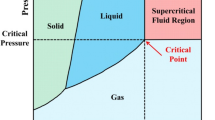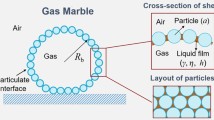Abstract
Aqueous foams are found in a wide range of industrial applications such as cosmetic, pharmaceutical, and food industries. These foam-based products are typically packaged in aerosol cans that are pressurized up to 3 bar. With pressure fluctuations over time, issues like coarsening and liquid drainage could affect the formulation. However, the rheological studies of foams under pressure are limited by the poor sensitivity and complex designs of traditional pressure cells that impose a lower torque limit of approximately 100 μN ⋅m. In this study, we detail the design and validation of a high-sensitivity pressurized Couette cell that utilizes a novel design to provide sample pressurization (up to 5 bar) with significantly improved torque sensitivity (1 μN ⋅m in oscillatory and 10 μN ⋅m in shear flows). Foam samples present experimental challenges due to a reduction in sample volume when pressurized. This has serious implications if a standard cylindrical cup and bob geometry is used with foam samples as it will be underfilled under pressurized conditions leading to erroneous results. To overcome this difficulty, we have designed a new rotor appropriately dimensioned that ensures a sufficient sample level over the entirety of the rotor under pressurized conditions. We demonstrate the application of this device by characterizing a commercial aqueous foam using traditional rheological methods such as flow ramps, oscillatory strain amplitude sweep, frequency sweep, time sweep, and stress growth under pressurized conditions.







Similar content being viewed by others
References
Ahuja A (2015) Hydrate-forming emulsion: rheology and morphology analysis for flow assurance. PhD Thesis The City College of the City University of New York, New York
Ahuja A, Gamonpilas C (2017) Dual yielding in capillary suspensions. Rheol Acta 56:801–810
Ahuja A, Potanin A (2018) Rheological and sensory properties of toothpaste. Rheol Acta 57:459
Ahuja A, Singh A (2009) Slip velocity of concentrated suspensions in couette flow. J Rheol 53:1461–1485
Ahuja A, Zylyftari G, Morris JF (2015a) Calorimetric and rheological studies on cyclopentane hydrate-forming water-in-kerosene emulsions. J of Chem & Eng Data 60:362–368
Ahuja A, Zylyftari G, Morris JF (2015b) Yield stress measurements of cyclopentane hydrate slurry. J Non-Newtonian Fluid Mech 220:116–125
Ahuja A, Peifer T, Yang CC, Ahmad O, Gamonpilas C (2018) Wall slip and multi-tier yielding in capillary suspensions. Rheol Acta 57:645–653
Ahuja A, Lu J, Potanin A (2019) Rheological predictions of sensory attributes of lotions. J Texture Stud, pp 1–11
Ahuja A, Lee R, Latshaw A, Foster P (2020a) Rheology of starch dispersions at high temperatures. J Texture Stud https://doi.org/10.1111/jtxs.12517
Ahuja A, Pappas I, Potanin A (2020b) Relation between structure and stability of toothpaste with two-step yielding. Rheol Acta, pp 133–145
Ahuja A, Potanin A, Joshi YM (2020c) Two step yielding in soft materials. Adv Colloid & Interface Sci. https://doi.org/10.1016/j.cis.2020.102179
Arzhavitina A, Steckel H (2010) Foams for pharmaceutical and cosmetic application. Soft Matter 394:1–17
Boukany PE, Wang S, Wang X (2009) Universal scaling behavior in startup shear of entangled linear polymer melts. J Rheol 53:617
Breuer H (1975) Stable aerosol shaving foams containing mineral oil. US Patent 3923970
Campbell GM, Mougeot E (1999) Creation and characterisation of aerated food products. Trends in Food Science & Technology 10:283–296
Cohen-Addad S, Hohler R (2014) Rheology of foams and highly concentrated emulsions. Current Opinion Colloid & Interface Science 19:536–548
Cohen-Addad S, Hoballah H, Hohler R (1998) Viscoelastic response of a coarsening foam. Phys Rev E 57:6897–6901
Denkov ND, Subramanian V, Gurovich D, Lips A (2005) Wall slip and viscous dissipation in sheared foams: effect of surface mobility. Colloids and Surfaces A: Physicochem Eng Aspects 263:129–145
Divoux T, Barentin C, Manneville S (2011) Stress overshoot in a simple yield stress fluids: an extensive study combining rheology and velocimetry. Soft Matter 7:9335–9349
Durian DJ, Weitz DA, Pine DJ (1991) Scaling behavior in shaving cream. Phys Rev A 44:R7902–R7905
Fischer NM, Windhab EJ (2005) Influence of process parameters on microstructure of food foam whipped in a rotor-stator device within a wide static pressure range. Colloids and Surfaces A: Physicochem Eng Aspects 263:353–362
Gardiner BS, Dlugogorski BZ, Jameson GJ (1998) Rheology of fire-fighting foams. Fire Safety Journal 31:61–75
Gopal AD, Durian DJ (1995) Nonlinear bubble dynamics in a slowly driven foam. Phys Rev Lett 75:2610–2613
Gopal AD, Durian DJ (1999) Shear-induced melting of an aqueous foam. J Colloid and Interfacial Sci 213:169–178
Green AJ, Littlejohn KA, Hooley P, Cox PW (2013) Formation and stability of food foams and aerated emulsions: hydrophobins as novel functional ingredients. Current Opinion in Colloid and Interfacial Science 18:292–301
Hanselmann W, Windhab E (1996) Foam flow in pipes. Appl Rheol, pp 253–260
Hanselmann W, Windhab E (1999) Flow characteristics and modelling of foam generation in a continuous rotor/stator mixer. J Food Engineering, pp 393–405
Herzhaft B (1999) Rheology of aqueous foams: a literature review of some experimental works. Oil & Gas Science and Technology - Rev IFP 54:587–596
Herzhaft B, Kakadjian S, Moan M (2005) Measurement and modeling of the flow behavior of aqueous foams using a recirculating pipe rheometer. Colloids and Surfaces A: Physicochem Eng Aspects 263:153–164
Heuer A, Cox AR, Singleton S, Barigou M, Ginkel M (2007) Visualization of foam microstructure when subject to pressure change. Col and Surf A: Physchem Eng Asp 311:112–123
Khan SA, Armstrong RC (1989) Rheology of foams IV: effect of gas volume fraction. J Rheol 33:881–911
Khan SA, Schnepper CA, Armstrong RC (1988) Foam rheology: III. Measurement of shear flow properties. J Rheol 32:69–92
Kraynik AM (1988) Foam flows. Ann Rev Fluid Mech 20:325–357
Kraynik AM, Hansen MG (1988) Foam rheology: a model of viscous phenomena. J Rheol 31:175–205
Kulisiewicz L, Delgado A (2010) High-pressure rheological methods: a review. Appl Rheol 20:13018
Lammers VRG, Morant A, Wemmer J, Windhab EJ (2017) High-pressure foaming properties of carbon dioxide-saturated emulsions. Rheol Acta 56:841–850
Marze S, Guillermic RM, Saint-Jalmes A (2009) Oscillatory rheology of aqueous foams: surfactant, liquid fraction, experimental protocol and aging effects. Soft Matter 5:1937–1946
Mende WC (1979) Pressurized foaming shaving composition. US Patent 4145411
Ovarlez G, Barral Q, Coussot P (2010) Three-dimensional jamming and flows of soft glassy materials. Nat Mater 9:115–119
Princen HM, Kiss AD (1986) Rheology of foams and highly concentrated emulsions. III. Static shear modulus. J Colloid Interface Sci 112:427–437
Prud’homme RK, Khan SA (1996) Foams: theory, measurements, and applications, vol 57. Surfactant Science Series. Marcel Dekker, New York
Richardson G, Bergenstahl B, Langton M, Stading M, Hermansson A (2004) The function of α-crystalline emulsifiers on expanding foam surfaces. Food Hydrocoll 18:655–663
Rouyer F, Cohen-Addad S, Hohler R (2005) Is the yield stress of aqueous foam a well-defined quantity? Colloids and Surfaces A: Physicochem Eng Aspects 263:111–116
Rouyer F, Cohen-Addad S, Hohler R, Sollich P, Fielding SM (2008) The large amplitude oscillatory strain response of aqueous foam: strain localization and full stress fourier spectrum. Eur Phys J E 27:309–321
Saint-Jalmes A, Durian DJ (1999) Vanishing elasticity for wet foams: equivalence with emulsions and role of polydispersity. J Rheol 43:1411
Shaukat A, Kaushal M, Sharma A, Joshi YM (2012) Shear mediated elongational flow and yielding in soft glassy materials. Soft Matter 8:10 114:107–10
Valko P, Economides MJ (1992) Volume equalized constitutive equations for foamed polymer solutions. J Rheol 36:1033
Yu Y, Soukup ZA, Saraji S (2019) An experimental study of in-situ foam rheology: effect of stabilizing and destabilizing agents. Colloids and Surfaces A 578:123–548
Zylyftari G, Ahuja A, Morris JF (2015) Modeling oilfield emulsions: comparison of cyclopentane hydrate and ice. Energy Fuels 29:6286–6295
Author information
Authors and Affiliations
Corresponding author
Additional information
Publisher’s note
Springer Nature remains neutral with regard to jurisdictional claims in published maps and institutional affiliations.
Electronic supplementary material
Below is the link to the electronic supplementary material.
Rights and permissions
About this article
Cite this article
Ahuja, A., Lee, R. & Foster, P. Rheology of aqueous foams under pressure. Rheol Acta 59, 639–649 (2020). https://doi.org/10.1007/s00397-020-01224-6
Received:
Revised:
Accepted:
Published:
Issue Date:
DOI: https://doi.org/10.1007/s00397-020-01224-6




